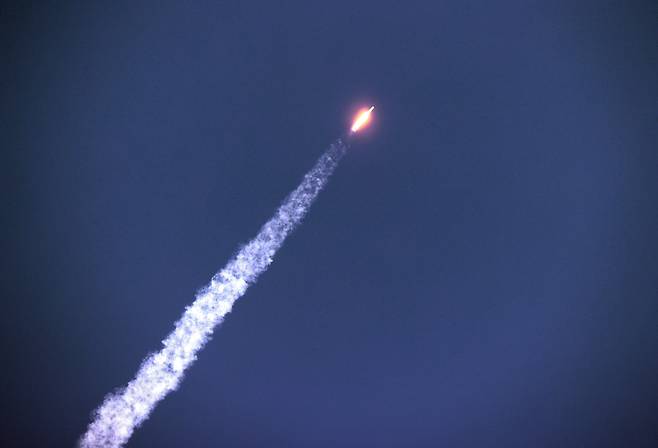[Newsmaker] Authorities to begin looking into data to explain why Nuri launch failed
이 글자크기로 변경됩니다.
(예시) 가장 빠른 뉴스가 있고 다양한 정보, 쌍방향 소통이 숨쉬는 다음뉴스를 만나보세요. 다음뉴스는 국내외 주요이슈와 실시간 속보, 문화생활 및 다양한 분야의 뉴스를 입체적으로 전달하고 있습니다.

South Korea’s Science Ministry said Sunday that researchers will begin looking into why the country’s first domestically-built rocket Nuri, or Korean Satellite Launch Vehicle II, failed to put a dummy satellite into orbit in its maiden flight last week.
The Korea Aerospace Research Institute that led the Nuri project will form a task force to examine data from the Oct. 21 test to determine what caused the shorter-than-programmed burning of the rocket’s third engine.
Named the Korean word meaning world, Nuri blasted off from the Naro Space Center in Goheung, South Jeolla Province, on Thursday afternoon.
The three-stage liquid-fueled satellite launcher completed its flight sequence, reaching a low orbit 700 kilometers above the Earth, but it failed to place the 1.5-ton dummy payload into orbit following the separation of the payload‘s first-stage, fairing, and second-stage rockets.
Science and ICT Minister Lim Hye-sook said during the press briefing on Thursday that the mock satellite could not reach the intended orbit because it failed to reach a speed of 7.5 kilometers per second.
Lim said that a 7-ton engine in the third-stage rocket was supposed to burn for 521 seconds, but only burned for 475 seconds, which led to a slowdown in the rocket’s speed at the end.
While some experts suggested that the shortened burning time could be due to flaws in the engine, KARI is leaving all possibilities open, such as a system error in the pressure tank, malfunction of valves attached in the third-stage or an error in the engine termination program as causes of the fault.
KARI said they plan to receive telemetry data gathered from Naro Space Center, tracking stations in the southern island of Jeju and Palau in the South Pacific for analysis.
Officials said that data from the Palau-based center will be essential in understanding what happened as it should have been able to record the latter part of the flight.
KARI opened the Palau center in 2019 to analyze real-time location and status of projectiles and payloads like Nuri. The center’s telemetry can receive data such as speed, acceleration, separation signal, image and more from a projectile as far away as 1,700 km.
If authorities cannot figure out why it failed, Nuri’s next test -- carrying actual satellites weighing 200 tons -- scheduled for May 19 can be delayed. Five additional launches are scheduled by 2027.
With the next Nuri model, South Korea aims to become the world’s seventh country with home-grown capabilities to launch a satellite weighing over 1 ton from its own soil.
The Moon Jae-in government has unveiled a plan that over the next decade, more than 100 satellites will be launched and aims to send an unmanned spaceship to the moon by 2030.
By Kim Da-sol(ddd@heraldcorp.com)
Copyright © 코리아헤럴드. 무단전재 및 재배포 금지.